
Elberton is the largest city in Elbert County, Georgia, United States. The population was 4,653 at the 2010 census. The city is the county seat of Elbert County.

Stone Mountain is a quartz monzonite dome monadnock and the site of Stone Mountain Park, 16 miles (26 km) east of Atlanta, Georgia. Outside the park is the small city of Stone Mountain, Georgia. The park is the most visited tourist site in the state of Georgia.

The Confederate Monument in Frankfort is placed within a circle of the graves of 68 Confederate soldiers in Frankfort Cemetery in Kentucky. The statue depicts a life size Confederate soldier standing ready, carved from white Carrara marble and standing atop a granite pedestal on a limestone base. A flagpole displays the first flag of the Confederacy with seven stars. The monument was erected by Daughters of the Confederacy and unveiled in 1892.
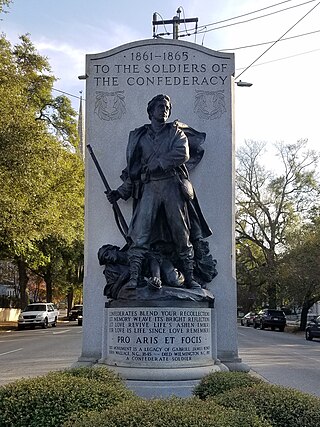
The Confederate Memorial was erected in 1924 by the estate of veteran Gabriel James Boney, the United Daughters of the Confederacy, and a Confederate veterans association in downtown Wilmington, North Carolina. In August 2021, the City of Wilmington removed it from public land and stored it, awaiting the UDC chapter to take possession.
Confederate monuments and memorials in the United States include public displays and symbols of the Confederate States of America (CSA), Confederate leaders, or Confederate soldiers of the American Civil War. Many monuments and memorials have been or will be removed under great controversy. Part of the commemoration of the American Civil War, these symbols include monuments and statues, flags, holidays and other observances, and the names of schools, roads, parks, bridges, buildings, counties, cities, lakes, dams, military bases, and other public structures. In a December 2018 special report, Smithsonian Magazine stated, "over the past ten years, taxpayers have directed at least $40 million to Confederate monuments—statues, homes, parks, museums, libraries, and cemeteries—and to Confederate heritage organizations."
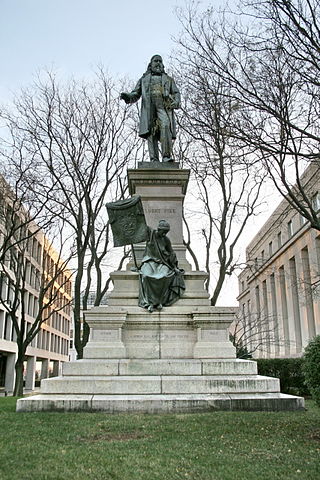
The Albert Pike Memorial is a public artwork in Washington, D.C., erected in 1901, and partially demolished in 2020 by protestors responding to the murder of George Floyd. It honors Albert Pike (1809–1891), a senior officer of the Confederate States Army as well as a poet, lawyer, and influential figure in the Scottish Rite of freemasonry. The memorial—which now only includes the base and Goddess of Masonry sculpture—sits near the corner of 3rd and D Streets NW in the Judiciary Square neighborhood. The memorial's two bronze figures were sculpted by Gaetano Trentanove, the Italian-American sculptor of another Washington, D.C., sculptural landmark, the Daniel Webster Memorial. The dedication ceremony in 1901 was attended by thousands of Masons who marched in a celebratory parade.

More than 160 monuments and memorials to the Confederate States of America and associated figures have been removed from public spaces in the United States, all but five since 2015. Some have been removed by state and local governments; others have been torn down by protestors.

The Four Southern Poets Monument, also known as the Monument to Southern Poets and Poets' Monument, is a granite monument in Augusta, Georgia, in the United States.
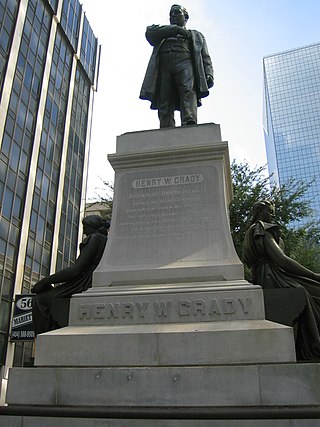
The Henry W. Grady statue is a monumental statue of Henry W. Grady in Atlanta, Georgia, United States. Built by Alexander Doyle in 1891, the statue lies at the intersection of Marietta Street and Forsyth Street in downtown Atlanta and was unveiled shortly after Grady's death in 1889. The statue has recently been the subject of controversy, as several groups have called for its removal due to Grady's support of white supremacy.

The Stonewall Jackson Monument in Richmond, Virginia, was erected in honor of Thomas Jonathon "Stonewall" Jackson, a Confederate general. The monument was located at the centre of the crossing of Monument Avenue and North Arthur Ashe Boulevard, in Richmond, Virginia. The bronze equestrian statue was unveiled in 1919. Along this avenue are other statues including Robert E. Lee, J. E. B. Stewart, Jefferson Davis, Matthew Maury and more recently Arthur Ashe. Thomas Jackson is best known as one of Robert E. Lee's most trusted commanders throughout the early period of the American Civil War between Southern Confederate states and Northern Union states. He rose to prominence after his vital role in the Confederate victory at the First Battle of Bull Run in July 1861, continuing to command troops until his untimely death on May 10, 1863, after falling fatally ill following the amputation of his wounded arm.

The Civil War Memorial in Savannah, Georgia, is a monument honoring soldiers who died during the American Civil War. Located in Forsyth Park, it consists of a 48 foot (15 m) tall shaft topped with a bronze statue of a Confederate soldier. Two bronze busts commemorating notable Confederate army officers flank the monument, which is protected by a railing, one of the only two that still stand around a monument, the other being the Casimir Pulaski Monument in Monterey Square. Originally known as the Confederate Monument, it was dedicated in 1875 to honor Confederate soldiers who died during the Civil War. Following the Unite the Right rally, the city of Savannah renamed and rededicated the structure in 2018. The monument is one of the oldest and largest Confederate monuments in Georgia.
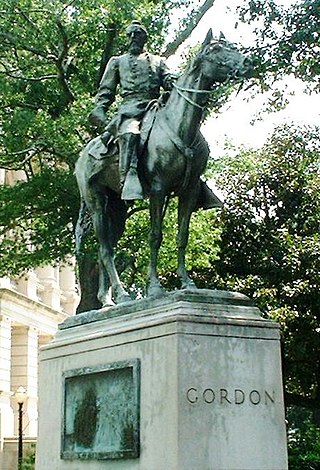
The equestrian statue of John Brown Gordon is a monument on the grounds of the Georgia State Capitol in Atlanta, Georgia, United States. The monument, an equestrian statue, honors John Brown Gordon, a general in the Confederate States Army during the American Civil War who later become a politician in post-Reconstruction era Georgia. Designed by Solon Borglum, the statue was dedicated in 1907 to large fanfare. The statue has recently become a figure of controversy over Gordon's racist views and associations with the Confederacy, with some calling for its removal.

The Martin Luther King Jr. statue is a public monument of civil rights activist Martin Luther King Jr. in Atlanta, Georgia. The statue, designed by Martin Dawe, was unveiled in 2017 and stands on the grounds of the Georgia State Capitol, overlooking Liberty Plaza.

Continuing the Conversation is a public sculpture honoring Rosa Parks in Atlanta, Georgia, United States. Located on the main campus of the Georgia Institute of Technology, the artwork was created by Martin Dawe and unveiled in 2018.
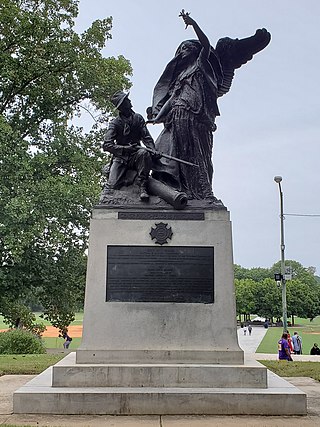
The Peace Monument is a public monument in Atlanta, Georgia, United States. Designed by Allen George Newman, the monument is located in Piedmont Park and was erected in 1911 by members of the Old Guard of the Gate City Guard, a Confederate-era militia, as a show of national unity in the years following the American Civil War. The monument has been the subject of controversy recently, with some calling for its removal as a symbol of the Lost Cause of the Confederacy.

The Confederate Obelisk is a large Confederate monument located in the Oakland Cemetery of Atlanta, Georgia, United States. The structure, a tall obelisk located in the cemetery's Confederate section, was dedicated in 1874. Due to its connection to the Confederate States of America, the monument has been vandalized repeatedly.
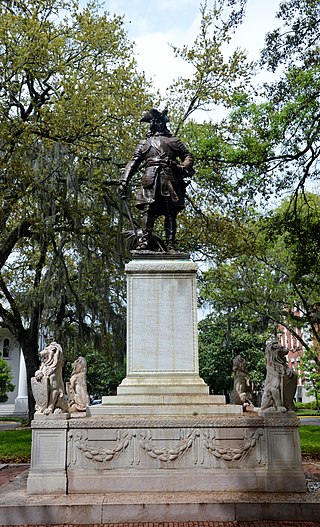
The James Oglethorpe Monument is a public monument in Chippewa Square, Savannah, Georgia, United States. The monument honors James Oglethorpe, the founder of the Province of Georgia, who established the city of Savannah in 1733. Efforts towards the monument's erection began in 1901 and were led by members of several patriotic groups in the city, who secured government funding for the monument. The monument consists of a bronze statue of Oglethorpe, designed by Daniel Chester French, atop a large granite pedestal designed by Henry Bacon. It was dedicated in 1910, in a ceremony that attracted several thousand spectators and was attended by several notable government officials.
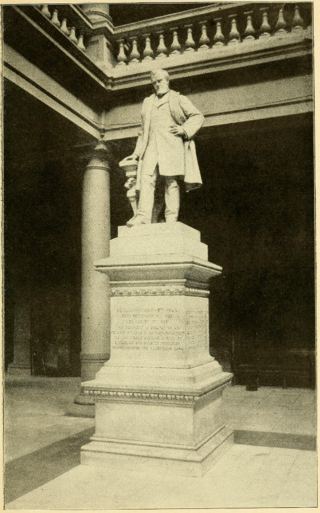
A statue of Benjamin Harvey Hill stands inside the Georgia State Capitol in Atlanta, Georgia, United States. The monumental statue was designed by American sculptor Alexander Doyle and originally dedicated in 1886 at what is now Hardy Ivy Park. The statue was relocated to the capitol building in 1890.


















